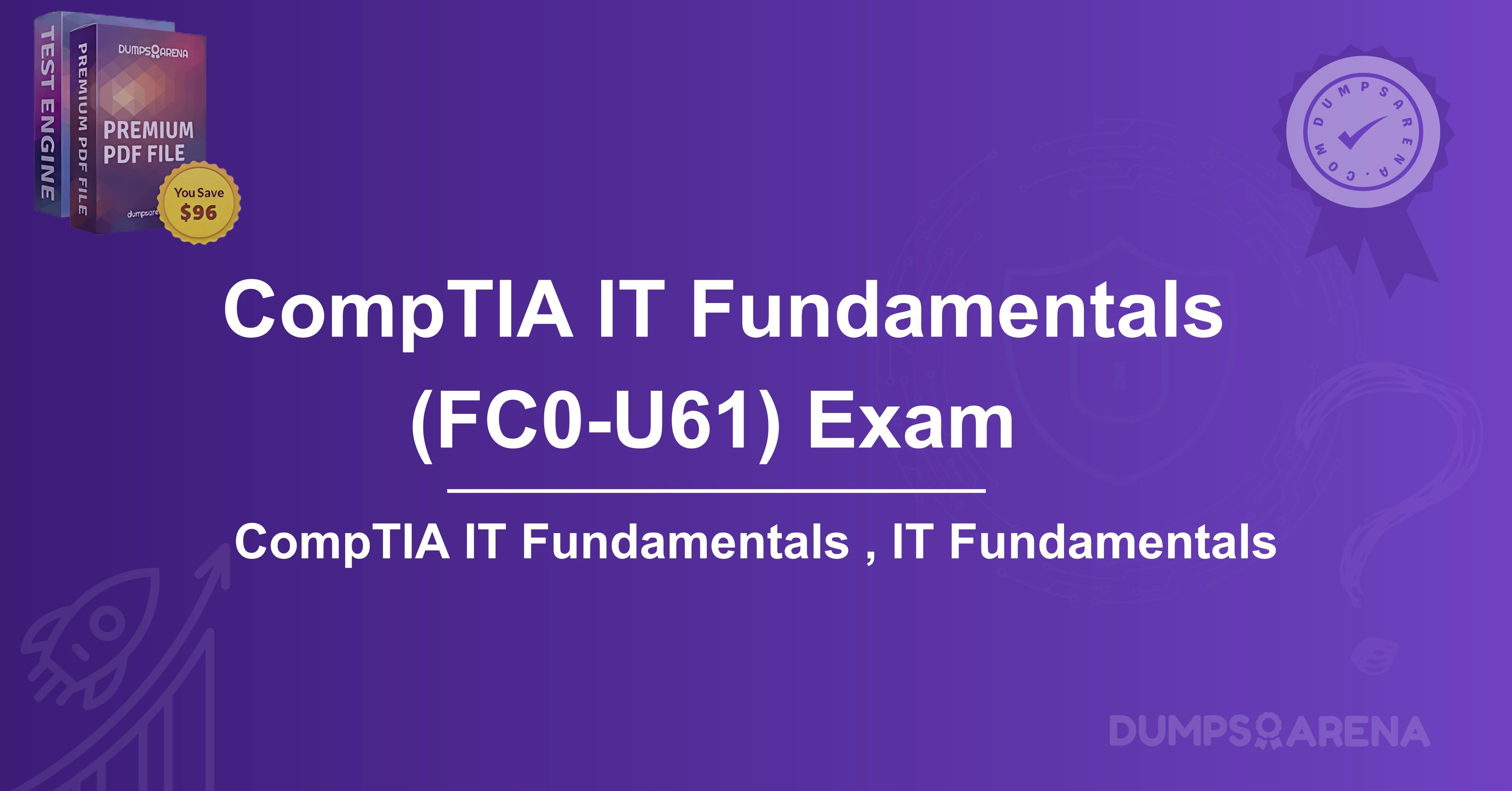Overview of the CompTIA IT Fundamentals (FC0-U61) Exam
The CompTIA IT Fundamentals (FC0-U61) exam is an entry-level certification designed for individuals looking to start a career in IT or validate their basic IT knowledge. This exam covers essential IT concepts, including hardware, software, networking, security, and troubleshooting.
Why Take the FC0-U61 Exam?
- Ideal for beginners – No prior IT experience is required.
- Validates foundational IT skills – Helps build confidence before pursuing advanced certifications like A+, Network+, or Security+.
- Enhances employability – Demonstrates a basic understanding of IT concepts to potential employers.
Exam Details:
- Duration: 60 minutes
- Passing Score: 650 (on a scale of 900)
- Number of Questions: 75
Understanding the FC0-U61 Exam
To pass the FC0-U61 exam, candidates must be familiar with the following domains:
IT Concepts and Terminology (17%)
- Understanding basic IT vocabulary (e.g., data, OS, applications).
- Differentiating between input, processing, output, and storage.
Infrastructure (22%)
- Identifying common hardware components (CPU, RAM, storage devices).
- Understanding networking concepts (Wi-Fi, routers, IP addresses).
Applications and Software (18%)
- Comparing different software types (open-source vs. proprietary).
- Understanding application delivery methods (cloud vs. local).
Software Development (12%)
- Basics of programming languages (Python, Java).
- Understanding databases and data structures.
Database Fundamentals (11%)
- Introduction to databases (tables, records, queries).
- Understanding database security best practices.
Security (20%)
- Recognizing security threats (malware, phishing).
- Implementing basic security measures (passwords, encryption).
Benefits of Using FC0-U61 Practice Tests
One of the most effective ways to prepare for the FC0-U61 exam is by using practice tests. Here’s why:
Familiarity with Exam Format
- Practice tests simulate the real exam environment, helping you get comfortable with question types and time constraints.
Identifying Knowledge Gaps
- By taking practice exams, you can pinpoint weak areas and focus your study efforts accordingly.
Improving Time Management
Since the exam is only 60 minutes long, practicing under timed conditions ensures you can answer all questions efficiently.
Boosting Confidence
- Repeated exposure to exam-style questions reduces test anxiety and increases confidence.
Reinforcing Key Concepts
- Practice tests reinforce important topics, ensuring better retention of crucial information.
How to Effectively Use FC0-U61 Practice Tests?
To maximize the benefits of practice tests, follow these strategies:
Start Early
- Begin taking practice tests early in your study plan to assess your baseline knowledge.
Simulate Real Exam Conditions
- Take full-length tests in a quiet environment with no distractions.
Review Incorrect Answers Thoroughly
- Don’t just memorize answers—understand why an answer is correct or incorrect.
Track Your Progress
- Keep a log of your scores to monitor improvement over time.
Combine with Other Study Materials
- Use practice tests alongside study guides, video tutorials, and hands-on labs for comprehensive preparation.
Recommended FC0-U61 Practice Test Resources
While there are many resources available, DumpsArena stands out as a top choice for FC0-U61 practice tests. Here’s why:
Why Choose DumpsArena?
- Up-to-date Questions – Aligned with the latest FC0-U61 exam objectives.
- Real Exam Simulation – Mimics the actual test environment.
- Detailed Explanations – Provide clear reasoning for each answer.
- Performance Analytics – Helps identify strengths and weaknesses.
- Affordable & Reliable – High-quality practice tests at a reasonable price.
Conclusion
Passing the CompTIA IT Fundamentals (FC0-U61) exam is a great first step toward an IT career. By understanding the exam structure, leveraging practice tests (especially from DumpsArena), and following a disciplined study plan, you can boost your chances of success.
Get Accurate & Authentic 500+ FC0-U61 Practice Test
Which of the following is an example of an open-source operating system?
A) Windows 11
B) macOS
C) Linux
D) iOS
What is the primary purpose of an SSD (Solid State Drive)?
A) To provide temporary storage for running applications
B) To store data permanently without moving parts
C) To connect peripheral devices to a computer
D) To cool down the CPU
Which protocol is used to securely transfer files over a network?
A) HTTP
B) FTP
C) SFTP
D) SMTP
What type of software prevents unauthorized access to a computer system?
A) Spreadsheet software
B) Antivirus software
C) Firewall
D) Database software
Which of the following is a characteristic of a strong password?
A) Uses common dictionary words
B) Contains personal information like birthdates
C) Includes a mix of uppercase, lowercase, numbers, and symbols
D) Is the same across multiple accounts
What does RAM stand for in computing?
A) Random Access Memory
B) Read-Only Memory
C) Redundant Array of Memory
D) Remote Access Module
Which cloud computing service model provides virtualized computing resources over the internet?
A) SaaS (Software as a Service)
B) PaaS (Platform as a Service)
C) IaaS (Infrastructure as a Service)
D) DaaS (Data as a Service)
What is the function of an IP address in networking?
A) To identify a website’s domain name
B) To uniquely identify a device on a network
C) To encrypt data transmissions
D) To provide wireless connectivity
Which programming language is primarily used for web development?
A) Python
B) Java
C) HTML
D) C++
What is the purpose of a UPS (Uninterruptible Power Supply)?
A) To increase internet speed
B) To provide backup power during outages
C) To cool down the CPU
D) To store large amounts of data



